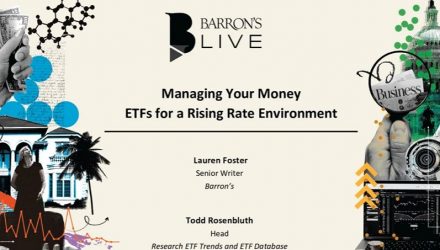On a recent podcast for Barron’s Live hosted by senior writer Lauren Foster, Todd Rosenbluth, head of research for ETF Trends and ETF Database, discusses active ETFs and ETFs to consider in a rising rate environment.
The discussion opens with Rosenbluth explaining that active funds that focus on risk reduction are currently performing stronger than other active strategies, given current environments. These risk-oriented strategies include downside risk reduction ones such as the JPMorgan Equity Premium Income ETF (JEPI), which is only down 2% YTD compared to the S&P 500’s 10% loss, and dividend-focused ETFs such as the T. Rowe Price Equity Income ETF (TEQI), which is up 1% YTD.
Certain thematic ETFs have also been a draw for investors, though many popular tech-heavy ones, such as the ARK Innovation ETF (ARKK), have taken a big hit.
“We’ve seen that investors and many advisors are long-term focused, and they are staying patient; they have confidence in the long-term thesis that Cathie Wood and the broader research team at ARK have,” Rosenbluth says.
Active funds are currently pulling in more than their fair share of inflows, almost triple the number of inflows for the amount of the market they represent. Not only is interest in active ETFs picking up, but the number of issuers and products they are offering continues to grow as well, including many flagship firms known for their active mutual funds, such as T. Rowe Price, Fidelity, and Doubleline.
It’s “particularly exciting if you’re a fan of active management but want the benefits of liquidity, low cost, and tax efficiency that ETFs offer; you get the best of both worlds,” Rosenbluth says.
The underperformance of the bond space has many advisors and investors pivoting from a traditional 60/40 portfolio to more of a 70/30 breakdown, allocating the extra 10% taken from fixed income into dividend strategy securities and ETFs. Popular funds include the Schwab U.S. Dividend Equity ETF (SCHD) and the Vanguard High Dividend Yield Index ETF (VYM).
“We’ve also seen investors being interested in what I’ll refer to as covered-call ETFs; I touched on one of them earlier, JEPI, which offers income using options in addition to the stocks,” Rosenbluth explains, as well as other ETFs that utilize similar mechanisms to provide income along with upside potential.
Emerging Markets and Rising Rate Investing
Discussion next turns to emerging markets and the difficulty that some of the broadly allocating funds have faced this year due to their exposure to China, which continues to be a challenging market for investors. Alternative options include the Invesco S&P Emerging Markets Low Volatility ETF (EELV), which was up 3.5% as of the end of last week while the broader exposure funds were down double digits, as well as the Freedom 100 Emerging Markets ETF (FRDM), a fund that invests in countries where there are economic and individual freedoms. FRDM does not have any exposure to China.
Pivoting to discuss investing in rising rates, Rosenbluth has advice for advisors and investors when thinking about investing in current markets and the rising rate environment.
“I think investors should have to think about whether your goal is to protect against the rising rate environment and the higher inflationary environment or your goal is to try and be rewarded by that,” Rosenbluth says.
From a defensive perspective, interest rate sensitivity (duration) awareness is critical within fixed income. A focus on shorter duration strategies tends to be the preferred approach to protecting against the downside. From a more offensive perspective that seeks rewards from rising rate environments, senior loan ETFs have been popular with advisors, Rosenbluth explains, because of their floating rates that adjust over time while investing in higher credit-risk companies.
Other topics covered included ESG and waning advisor and investor interest in general ESG-related funds, aerospace and defense funds, inflation-related investing such as gold and commodities, and alternatives investing.
To listen to the entire podcast featuring Todd Rosenbluth, click here.
To subscribe to Todd’s research, reports, and commentary on a regular basis, please subscribe here.
